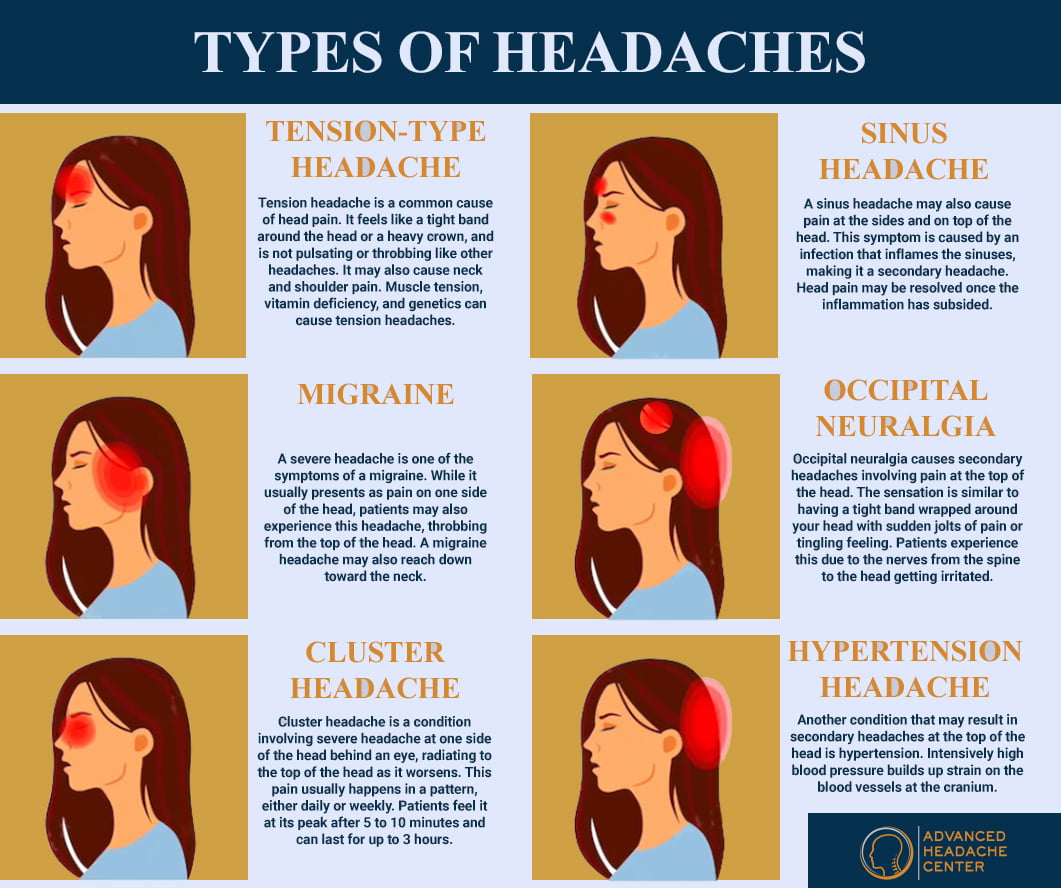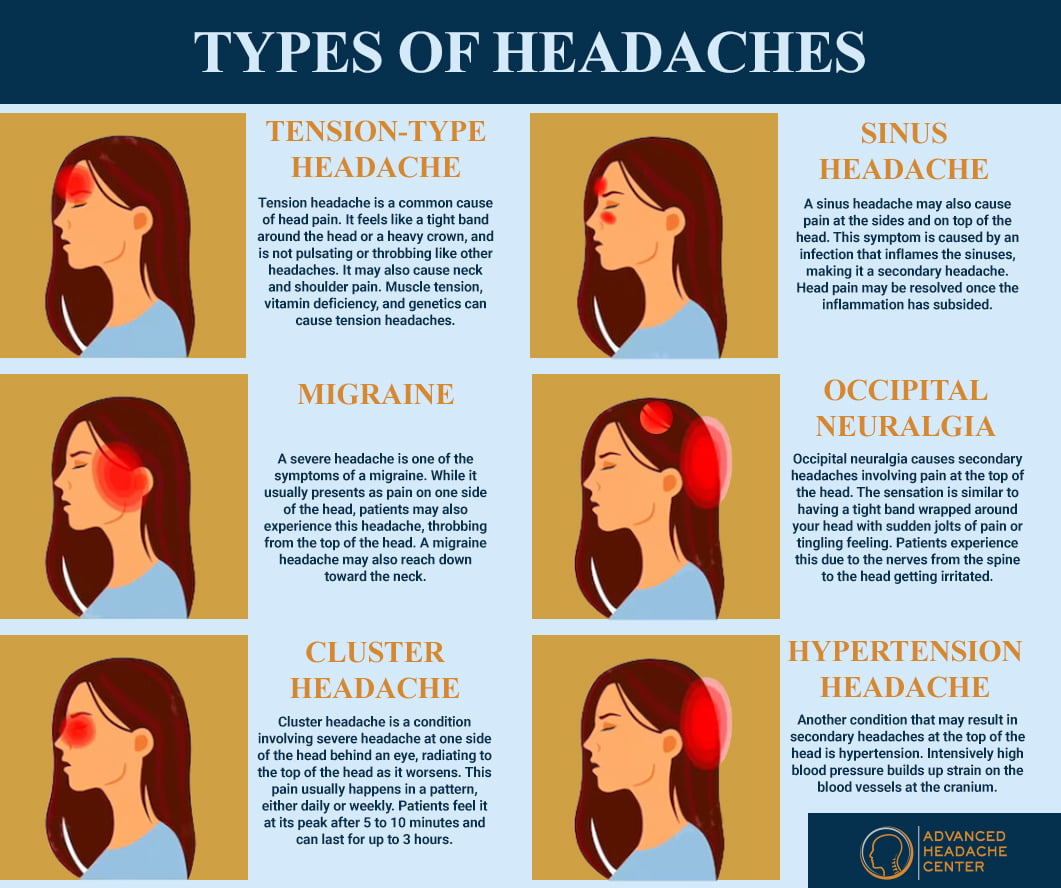The Culprits: 8 Surprising Reasons Why Your Headaches Keep Coming Back
The relentless drumbeat behind your eyes. The vise-like grip around your temples. The pulsating throb that steals your focus, your joy, and sometimes, your very will to engage with the world. For millions, headaches aren’t just an occasional nuisance; they are a chronic, debilitating presence, a shadow cast over days, weeks, and even years. You’ve tried the usual suspects: more sleep, less caffeine, pain relievers. Yet, the unwelcome guest keeps returning, often with a frustrating, bewildering consistency.
If you’ve found yourself trapped in this cycle, perpetually searching for answers, you’re not alone. The journey to understanding chronic headaches often feels like a detective story, where the obvious clues lead to dead ends, and the true culprits hide in plain sight, or in the subtle, often overlooked corners of our physiology and environment.
This isn’t an article about the common, fleeting headache. This is for the knowledgeable, the persistent, the ones who suspect there’s more to their recurring pain than meets the eye. We’re going to delve into eight surprising, often interconnected reasons why your headaches might be stubbornly refusing to leave, unveiling the hidden mechanisms and offering paths to discovery and relief. Prepare to become a detective in your own health journey, because the answers may surprise you.
>
1. The Paradox of Relief: Medication Overuse Headaches (MOH)
Imagine a life raft that, over time, starts to fill with water, slowly sinking the very person it was meant to save. This unsettling metaphor aptly describes the insidious nature of Medication Overuse Headaches (MOH), also known as rebound headaches. It’s perhaps the cruelest irony for chronic headache sufferers: the very medicine you take to alleviate your pain can, in excess, become the primary driver of its persistence.
The Mechanism:
For a knowledgeable audience, understanding the physiological dance behind MOH is crucial. When pain relievers – especially acute medications like triptans, opioids, or even simple analgesics like ibuprofen and acetaminophen (when taken frequently) – are used more than 2-3 days a week, they can paradoxically alter the brain’s pain processing pathways. The brain becomes "sensitized" to pain signals, and as the medication wears off, a withdrawal phenomenon occurs, triggering another headache. This creates a vicious cycle: headache leads to medication, medication wears off, leading to a worse headache, which demands more medication, ad infinitum. The threshold for pain lowers, and the brain’s natural pain-modulating systems become dysregulated. Serotonergic pathways, critical for migraine control, can become particularly affected.
The Clues:
MOH often manifests as a daily or near-daily headache, frequently present upon waking, or developing shortly after the previous dose of medication wears off. The character of the headache might change over time, becoming more diffuse, less responsive to medication, and often accompanied by symptoms like nausea, irritability, difficulty concentrating, and anxiety. If your headaches are worse on days you don’t take medication, or if the efficacy of your usual pain relievers seems to be diminishing, MOH should be a prime suspect.
The Path to Discovery & Relief:
Diagnosis is primarily clinical, based on a detailed medication history. The treatment, while initially daunting, is crucial: controlled withdrawal from the overused medication. This process often involves stopping the offending medication abruptly or tapering it down under medical supervision, often accompanied by a temporary increase in headache severity. However, this "detox" period is often followed by a significant reduction in headache frequency and intensity. Preventative medications, lifestyle adjustments, and behavioral therapies (like biofeedback or cognitive behavioral therapy) are often introduced during and after withdrawal to break the cycle and prevent recurrence.
>
2. The Silent Squeeze: Temporomandibular Joint (TMJ) Dysfunction
Beneath the surface of your smile, a complex symphony of bone, muscle, and nerve dictates the opening and closing of your jaw. The temporomandibular joint (TMJ), a hinge that connects your jaw to the temporal bones of your skull, is remarkably intricate. When this joint, or the muscles surrounding it, become dysfunctional, it can silently generate a surprising array of symptoms, including persistent headaches.
The Mechanism:
TMJ dysfunction, or TMD, is not a single condition but a spectrum of issues affecting the jaw joints and chewing muscles. These can include bruxism (teeth grinding or clenching, often nocturnal), disc displacement within the joint, arthritis, or muscle spasms. The trigeminal nerve, a major cranial nerve, innervates the TMJ and face, and its branches connect to areas responsible for headache pain. Chronic muscle tension in the jaw, neck, and shoulders, often a compensatory mechanism for TMD, can also refer pain to the head, mimicking tension-type headaches or even triggering migraines. This referred pain pathway is critical to understanding the headache connection. Moreover, the constant inflammation or stress on the joint can activate central pain pathways, making the brain more susceptible to headache generation.
The Clues:
The headaches associated with TMD are often described as dull, aching, and localized to the temples, forehead, or behind the eyes. They may be unilateral or bilateral. Key accompanying symptoms include jaw pain, clicking or popping sounds in the jaw, difficulty opening or closing the mouth fully, earaches, tinnitus, facial pain, and neck or shoulder stiffness. You might notice your jaw feels tired or sore upon waking if you clench or grind your teeth at night. Stress, a common trigger for both headaches and TMD, can exacerbate the symptoms.
The Path to Discovery & Relief:
Diagnosis often involves a physical examination by a dentist or oral surgeon, evaluating jaw movement, tenderness, and joint sounds. Imaging (X-rays, MRI) may be used to assess the joint structure. Treatment is multifaceted, focusing on reducing muscle tension and restoring proper jaw mechanics. This can include custom-fitted oral splints (nightguards) to prevent grinding, physical therapy for the jaw and neck, muscle relaxants, anti-inflammatory medications, stress management techniques, and in severe cases, minimally invasive procedures or surgery. Addressing underlying causes like poor posture or chronic stress is also vital.
>
3. The Invisible Drain: Nutritional Deficiencies
Our bodies are complex biochemical machines, reliant on a precise intake of micronutrients to function optimally. While dramatic nutritional deficiencies are rare in developed countries, subtle, chronic insufficiencies can act as invisible drains on our system, subtly contributing to, or even directly causing, persistent headaches. For a knowledgeable individual, understanding the specific roles of certain nutrients can illuminate this often-overlooked connection.
The Mechanism:
Several key nutrients play critical roles in neurological function, vascular regulation, and inflammation, all of which are intimately linked to headache pathophysiology.
- Magnesium: This essential mineral is involved in over 300 enzymatic reactions, including nerve transmission, muscle contraction, and blood vessel tone. Magnesium deficiency can lead to increased neuronal excitability, neurotransmitter imbalances (like serotonin), and cerebral vasoconstriction, all potent headache triggers. It also plays a role in energy production (ATP) and mitochondrial function, which are implicated in migraine.
- Riboflavin (Vitamin B2): A precursor to coenzymes involved in cellular energy production, particularly in the mitochondria. Deficiencies can impair cellular metabolism, making brain cells more vulnerable to stress and oxidative damage, a known factor in migraine genesis.
- Coenzyme Q10 (CoQ10): Another crucial component of the electron transport chain in mitochondria. Lower levels can lead to reduced energy production and increased oxidative stress, contributing to neurological dysfunction and headache susceptibility.
- Vitamin D: Beyond bone health, Vitamin D has significant anti-inflammatory and immunomodulatory effects. Chronic low-grade inflammation is a known contributor to pain sensitization and headache frequency.
- B Vitamins (especially B6, B9/Folate, B12): These are vital for homocysteine metabolism. Elevated homocysteine levels, a marker of inflammation and vascular stress, have been linked to migraine risk. They also support neurotransmitter synthesis.
The Clues:
Nutritional deficiency headaches often present as chronic, low-grade pain, though they can also trigger more severe episodes. Accompanying symptoms might include fatigue, muscle weakness or cramps, irritability, numbness or tingling (B vitamin deficiency), or a general feeling of malaise. They are often overlooked because the symptoms are diffuse and easily attributed to other causes.
The Path to Discovery & Relief:
A thorough dietary assessment and blood tests can reveal deficiencies. However, standard lab ranges for some nutrients (like magnesium) may not reflect optimal cellular levels. Working with a healthcare provider knowledgeable in functional medicine can be beneficial. Treatment involves dietary modifications to increase intake of nutrient-rich foods (leafy greens, nuts, seeds, whole grains, fatty fish) and, crucially, targeted supplementation under medical guidance. Simply taking a multivitamin may not be enough; specific, higher-dose supplementation of individual nutrients like magnesium, riboflavin, or CoQ10 has shown efficacy in reducing headache frequency and severity, particularly for migraine.
>
4. The Hormonal Roller Coaster: Imbalances & Fluctuations
For many, especially women, headaches are inextricably linked to the ebb and flow of hormones. While often dismissed as "just hormones," the intricate dance of estrogen and progesterone, and their impact on neurobiology, can be a powerful and often surprising driver of chronic head pain. But it’s not just about the female cycle; hormonal shifts can affect anyone.
The Mechanism:
Estrogen, in particular, plays a significant role in headache susceptibility. It influences neurotransmitters like serotonin, which is central to migraine pathophysiology, and affects vascular tone. Fluctuations in estrogen levels – not just absolute levels – are often the trigger.
- Estrogen Withdrawal: The sharp drop in estrogen levels just before menstruation (catamenial migraine) is a classic example. Similarly, the perimenopausal period, characterized by unpredictable hormonal swings, is a common time for worsening headaches.
- Estrogen Dominance/Progesterone Deficiency: An imbalance where estrogen levels are relatively high compared to progesterone can also contribute to inflammation and vascular reactivity, potentially worsening headaches.
- Oral Contraceptives/Hormone Replacement Therapy (HRT): While some women find relief, others experience worsening headaches due to the synthetic hormones. Continuous-dose pills or patches might be better than cyclical ones for some.
- Thyroid Hormones: Both hypothyroidism (underactive) and hyperthyroidism (overactive) can cause headaches, as thyroid hormones regulate metabolism and neurotransmitter function throughout the body.
- Cortisol: Chronic stress leads to elevated cortisol, which can dysregulate other hormones and contribute to systemic inflammation, impacting headache frequency.
The Clues:
Hormonally-driven headaches often follow a cyclical pattern, worsening around specific times in the menstrual cycle, ovulation, or during perimenopause. They may be accompanied by other hormonal symptoms like mood swings, fatigue, hot flashes, irregular periods, or weight changes. For men, less common hormonal imbalances, such as low testosterone, can also contribute to headaches, though the link is less direct and often involves other factors like sleep disruption or mood changes.
The Path to Discovery & Relief:
Careful tracking of headache frequency and severity in relation to menstrual cycles, life stages, and medication use is paramount. Blood tests can assess levels of estrogen, progesterone, thyroid hormones, and sometimes cortisol. Treatment options are highly individualized:
- Lifestyle: Stress management, consistent sleep, and a balanced diet can help stabilize hormone levels.
- Hormonal Therapies: For women, this might include continuous-dose oral contraceptives, transdermal estrogen patches, or progesterone therapy, always in consultation with a gynecologist or endocrinologist.
- Herbal Remedies: Certain herbs like Vitex agnus-castus (Chasteberry) may help balance hormones, but should be used under guidance.
- Thyroid Management: If thyroid dysfunction is identified, appropriate medication will be prescribed. The goal is to smooth out hormonal fluctuations and reduce their inflammatory impact.
>
5. The Ergonomic Trap: Postural & Ergonomic Flaws
In our increasingly digital world, the posture of modern life—hunched over screens, craning necks, sedentary hours—has created a silent epidemic of musculoskeletal strain. What might seem like a mere discomfort can, over time, become a significant and surprising driver of chronic headaches. These are often labeled as cervicogenic headaches, but the scope extends beyond just the neck.
The Mechanism:
Poor posture, particularly in the cervical spine (neck) and upper back, creates chronic tension in the muscles and connective tissues of the neck, shoulders, and scalp. The suboccipital muscles, located at the base of the skull, are particularly implicated. When these muscles are constantly strained, they can refer pain forward to the head, often mimicking tension headaches.
- Nerve Compression: Sustained poor posture can also compress nerves exiting the cervical spine, particularly the greater and lesser occipital nerves, leading to occipital neuralgia, which presents as sharp, shooting, or aching pain at the back of the head, radiating over the scalp.
- Muscle Imbalance: The "forward head posture" common with screen use leads to weakened deep neck flexors and overactive superficial extensors, further perpetuating the cycle of tension and pain.
- Ergonomic Mismatch: An ill-fitting desk setup, a non-supportive chair, or even an incorrect pillow can maintain the body in positions that stress the neck and upper back for hours on end, leading to cumulative strain.
The Clues:
Headaches stemming from postural issues are often felt at the base of the skull, radiating up into the scalp, temples, or behind the eyes. They may be unilateral or bilateral. Key accompanying symptoms include neck stiffness, shoulder pain, limited range of motion in the neck, and tenderness in the neck and upper back muscles. The pain often worsens with prolonged sitting, computer use, or specific neck movements. It might feel better with movement or massage.
The Path to Discovery & Relief:
Diagnosis involves a thorough physical examination by a physical therapist, chiropractor, or physician, assessing posture, range of motion, muscle tenderness, and neurological signs. Imaging (X-rays, MRI) may be used to rule out structural abnormalities. Treatment is highly effective and focuses on correcting underlying biomechanical issues:
- Ergonomic Assessment: Optimizing your workstation (monitor height, chair support, keyboard/mouse placement) is crucial.
- Physical Therapy: Targeted exercises to strengthen weak muscles, stretch tight ones, and improve posture. Manual therapy (massage, mobilization) can release muscle tension.
- Awareness & Breaks: Regular movement breaks, conscious postural correction throughout the day.
- Pillow Optimization: A supportive pillow that maintains neutral neck alignment during sleep.
- Stress Management: Stress often manifests as muscle tension, exacerbating postural issues.
>
6. The Invisible Assault: Environmental Sensitivities
Our internal environment is constantly interacting with the external world, often in ways we don’t consciously perceive. For some, certain environmental factors, far more subtle than typical allergens, can act as powerful and surprising triggers for recurring headaches. These aren’t just about pollen counts; they delve into the realms of barometric pressure and chemical sensitivities.
The Mechanism:
- Barometric Pressure Changes: The most common and often overlooked environmental trigger. Rapid changes in atmospheric pressure (associated with weather fronts, storms, or even altitude changes) can affect the pressure within the sinuses and inner ear. For some individuals, this pressure differential can trigger headaches and migraines, possibly by affecting blood flow to the brain, stimulating cranial nerves, or influencing fluid dynamics in the inner ear. The exact mechanism is still under investigation, but it’s believed that changes in pressure can activate pain receptors in the dura mater (the brain’s outer covering) or affect the trigeminal nerve.
- Volatile Organic Compounds (VOCs) & Chemical Sensitivities: Common household products, new furniture, paints, perfumes, cleaning supplies, and even car interiors off-gas VOCs. For individuals with chemical sensitivities, exposure to these compounds can trigger headaches, nausea, dizziness, and respiratory irritation. This can involve direct irritation of nasal and sinus passages, activation of the olfactory nerve leading to central nervous system effects, or even a mast cell activation response.
- Light & Sound: While not strictly environmental "sensitivities" in the same vein as pressure or chemicals, specific frequencies of light (fluorescent lights, flickering screens) and certain sounds can overwhelm the nervous system, particularly for those with hyper-sensitized pain pathways, leading to headache exacerbation.
The Clues:
Environmental headaches often seem to appear "out of nowhere" or without an obvious internal trigger. They might worsen during specific weather patterns, after entering newly painted rooms, or when exposed to strong scents. Accompanying symptoms might include sinus pressure, ear fullness, dizziness, or a general feeling of being unwell. If your headaches are worse on rainy days, before a storm, or when you spend time in certain indoor environments, these factors should be considered.
The Path to Discovery & Relief:
Tracking is key: note weather changes, specific locations, and chemical exposures in your headache diary.
- Barometric Pressure: While you can’t control the weather, some apps can alert you to upcoming pressure changes, allowing for proactive management (e.g., staying hydrated, avoiding other triggers). Some individuals find relief with antihistamines or decongestants if sinus pressure is involved, though caution is advised with overuse.
- Chemical Sensitivities: Identify and eliminate sources of VOCs in your home and workplace. Opt for fragrance-free products, natural cleaning supplies, and improve ventilation. Air purifiers with activated carbon filters can help.
- Light & Sound: Use blue-light-blocking glasses for screens, ensure adequate natural light, and avoid flickering lights. Use earplugs or noise-canceling headphones in noisy environments. The goal is to minimize exposure to identified triggers and create a "safe" sensory environment.
>
7. The Nighttime Saboteur: Undiagnosed Sleep Disorders
We often attribute morning headaches to a simple "lack of sleep," but the issue can be far more complex and insidious. Undiagnosed sleep disorders, quietly wreaking havoc on your body’s physiology throughout the night, are surprisingly common culprits behind chronic, recurring headaches, particularly those present upon waking.
The Mechanism:
- Sleep Apnea (Obstructive and Central): This is arguably the most significant sleep disorder linked to headaches. During apneic episodes, breathing repeatedly stops and starts, leading to intermittent hypoxia (low blood oxygen) and hypercapnia (high blood carbon dioxide). These changes in blood gas levels cause cerebral vasodilation (widening of blood vessels in the brain), which is a powerful headache trigger. Fragmented sleep due to constant awakenings also disrupts restorative sleep stages and pain modulation pathways.
- Insomnia: While "lack of sleep" is a simple phrase, chronic insomnia, characterized by difficulty falling or staying asleep, leads to significant sleep deprivation. This can lower pain thresholds, increase inflammation, and disrupt neurotransmitter balance, making headache attacks more frequent and severe.
- Restless Legs Syndrome (RLS) & Periodic Limb Movement Disorder (PLMD): These conditions involve uncomfortable sensations and involuntary leg movements that disrupt sleep. The constant micro-arousals prevent deep, restorative sleep, similar to sleep apnea, contributing to chronic fatigue and headache susceptibility.
- Circadian Rhythm Disorders: Irregular sleep-wake cycles (common in shift workers or those with jet lag) disrupt the body’s natural rhythms, including hormone release and pain perception, which can trigger headaches.
The Clues:
Headaches related to sleep disorders are very often present upon waking and may gradually improve throughout the day. They are often described as dull, diffuse, and bilateral. Key accompanying symptoms include loud snoring (a hallmark of sleep apnea), daytime sleepiness, fatigue despite adequate time in bed, irritability, difficulty concentrating, mood changes, and for RLS/PLMD, an irresistible urge to move the legs, especially at night. A bed partner might report pauses in your breathing or restless movements.
The Path to Discovery & Relief:
If you suspect a sleep disorder, the first step is to consult a physician and consider a sleep study (polysomnography). This diagnostic test monitors various physiological parameters during sleep, providing definitive answers.
- Sleep Apnea: Treatment often involves Continuous Positive Airway Pressure (CPAP) therapy, oral appliances, or lifestyle changes (weight loss, avoiding alcohol before bed, sleeping on your side).
- Insomnia: Cognitive Behavioral Therapy for Insomnia (CBT-I) is highly effective, alongside optimizing sleep hygiene (consistent sleep schedule, dark/cool/quiet bedroom, avoiding screens before bed).
- RLS/PLMD: Treatment can involve addressing underlying iron deficiency, lifestyle changes, and sometimes medication.
Addressing the underlying sleep disorder is often profoundly effective in reducing headache frequency and severity, as it restores the body’s natural restorative and pain-modulating processes.
>
8. The Gut-Brain Axis & The Silent Fire: Chronic Low-Grade Inflammation & Gut Dysbiosis
This final culprit might be the most surprising and cutting-edge, yet increasingly recognized, driver of chronic headaches. It points to a profound connection between our digestive health, systemic inflammation, and brain function – the intricate dance of the gut-brain axis.
The Mechanism:
- Gut Dysbiosis: The human gut hosts trillions of microorganisms (the microbiome) that play a vital role in digestion, nutrient absorption, and immune function. When this delicate balance is disrupted (dysbiosis), harmful bacteria can proliferate, leading to increased intestinal permeability, often referred to as "leaky gut." This allows undigested food particles, toxins, and bacterial byproducts to leak into the bloodstream.
- Chronic Low-Grade Inflammation: The immune system detects these foreign invaders, triggering a systemic inflammatory response. This "silent fire" of chronic inflammation, characterized by elevated pro-inflammatory cytokines, doesn’t always manifest as acute pain. Instead, it can sensitize pain pathways in the central nervous system, making the brain more reactive to pain signals and lowering the headache threshold.
- Neurotransmitter Production: The gut is often called the "second brain" because it produces a vast array of neurotransmitters, including serotonin (a key player in migraine). Gut dysbiosis can impair this production, leading to imbalances that contribute to headache susceptibility.
- Vagus Nerve: The vagus nerve is a major communication highway between the gut and the brain. Inflammation in the gut can activate the vagus nerve, sending distress signals to the brain that contribute to pain and autonomic dysfunction.
- Food Sensitivities: While not true allergies, sensitivities to certain foods (e.g., gluten, dairy, specific additives like MSG or artificial sweeteners) can trigger an immune response in the gut, leading to inflammation and subsequent headaches in susceptible individuals.
The Clues:
Headaches linked to gut dysbiosis and inflammation often present as chronic, persistent, and sometimes difficult-to-categorize pain. They might be accompanied by a constellation of seemingly unrelated symptoms: digestive issues (bloating, gas, constipation, diarrhea, IBS), fatigue, brain fog, skin problems (acne, eczema), joint pain, mood disturbances (anxiety, depression), and generalized malaise. The connection often becomes apparent when individuals notice a correlation between certain foods or digestive flare-ups and their headaches.
The Path to Discovery & Relief:
This area requires a holistic and often functional medicine approach.
- Elimination Diet: A carefully managed elimination diet (e.g., specific carbohydrate diet, low FODMAP, or simply eliminating common culprits like gluten, dairy, soy, corn) can help identify food sensitivities.
- Gut Health Assessment: Stool tests can analyze the microbiome composition, identify dysbiosis, and check for markers of inflammation and intestinal permeability.
- Anti-inflammatory Diet: Adopting a whole-foods-based, anti-inflammatory diet rich in fruits, vegetables, lean proteins, healthy fats, and fermented foods.
- Probiotics & Prebiotics: Supplementation with targeted probiotics and prebiotics (fibers that feed beneficial bacteria) can help restore gut balance.
- Stress Reduction: Chronic stress profoundly impacts gut health, so incorporating mindfulness, meditation, or yoga is beneficial.
- Addressing Root Causes: Working with a healthcare provider to identify and address specific gut pathogens, SIBO (Small Intestinal Bacterial Overgrowth), or other digestive issues. By calming the "silent fire" in the gut, the systemic inflammatory load on the body, and thus the brain, can be significantly reduced, leading to a surprising and often profound reduction in headache frequency and severity.
>
The Interwoven Tapestry: A Holistic Perspective
It’s crucial to understand that these eight culprits rarely operate in isolation. Instead, they often form an intricate, interwoven tapestry, each thread influencing and exacerbating the others. Chronic stress, for example, can worsen TMJ dysfunction, disrupt sleep, contribute to hormonal imbalances, and wreak havoc on gut health. A magnesium deficiency might make you more susceptible to hormonal fluctuations or environmental triggers. The human body is a complex, interconnected system, and a holistic perspective is essential for unravelling the mystery of persistent headaches.
The journey to headache relief is rarely a straight line. It demands patience, meticulous observation, and a willingness to explore beyond the obvious. It requires you to become a detective in your own body, piecing together the subtle clues and connecting seemingly disparate symptoms.
Your Path Forward: Empowerment Through Discovery
The good news is that understanding these surprising culprits empowers you. It shifts the narrative from passive suffering to active investigation. If you’ve been battling chronic headaches with limited success, consider these eight areas as potential avenues for discovery:
- Review Your Medication Use: Be honest about your intake of acute pain relievers.
- Assess Your Jaw & Neck: Pay attention to jaw clicking, teeth grinding, or neck stiffness.
- Evaluate Your Diet & Supplements: Are you getting adequate magnesium, B vitamins, and CoQ10?
- Track Your Hormones: Notice patterns related to menstrual cycles, perimenopause, or other hormonal shifts.
- Examine Your Ergonomics: How do you sit, stand, and sleep?
- Consider Your Environment: Are certain weather patterns or chemical exposures consistent triggers?
- Investigate Your Sleep: Are you truly getting restorative sleep, or is something disrupting it?
- Heal Your Gut: Are digestive issues, food sensitivities, or general inflammation playing a role?
Don’t embark on this journey alone. Share your observations and suspicions with a healthcare provider who is open to a comprehensive, investigative approach. This might involve consulting a neurologist, a functional medicine practitioner, a physical therapist, a sleep specialist, or a dentist specializing in TMD.
The answers to your recurring headaches may not be simple, but they are often profound and within reach. By understanding these surprising culprits, you’re not just seeking relief; you’re reclaiming your health, your focus, and your quality of life, one clue at a time. The story of your headaches doesn’t have to be one of endless suffering; it can be one of discovery, understanding, and ultimately, freedom.






